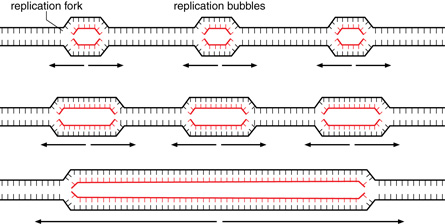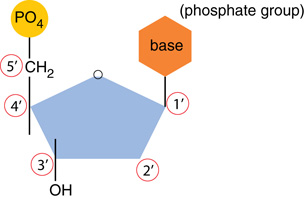Module 7
1. Module 7
1.7. Page 2
Module 7—Molecular Genetics: DNA, RNA, and Protein Synthesis
 Explore
Explore
 Read
Read
DNA and RNA are both nucleic acids. However, their structures and functions are very different. These differences become significant in DNA replication and in protein synthesis. You will learn about DNA replication in this lesson; however, protein synthesis will be examined in Lesson 3. To better understand the differences between the structures of DNA and RNA, read page 629 in the textbook, “RNA.” An excellent way to summarize the differences between DNA and RNA is in a comparative chart. As you work through this module, you should create a chart to add information about these differences, including a comparison of the number of strands, type of sugar present, type of nitrogen bases in each molecule, location of the molecules, and role. This chart will be useful as a summary and study aid.
genome: the sum, or the entire DNA, carried in an organism’s cells
semi-conservative: term used to describe replication where each new molecule of DNA contains one strand of the original complementary DNA and one new strand, conserving half of the original molecule
In Module 5 you learned that when a cell divides to form two new cells, it must replicate, or make a copy of its entire DNA—the entire genome! In the last lesson you began learning about this DNA replication method by studying the structure of the DNA molecule. The double-stranded structure of DNA leads to a special copying mechanism noted by Watson and Crick. When a cell creates copies of its DNA by way of DNA replication, the new molecules of DNA each contain one of the original strands of the DNA.
This makes replication a semi-conservative process: the new molecules of DNA have one “old” or original strand, and one “new” or newly formed strand. Examine “Figure 18.8” on page 631 of the textbook to see how one strand of the original “blue” DNA is found in each of the new copies of DNA, or examine the diagram provided below. To become familiar with the features of DNA replication, read from “Genes and the Genome” on page 629 to “Section 18.1 Summary” on page 633 in the textbook.
DNA replication is an important concept to master. You may wish to complete the Read and Watch and Listen sections to ensure your understanding before you attempt to summarize the information for your course folder. According to your learning style, decide on the best way to summarize this information.

Initiation of DNA Replication
replication origin: specific nucleotide sequence where replication begins
helicase: an enzyme that breaks segments of DNA during DNA replication; used in technologies to fragment DNA
replication bubble: oval-shaped, unwound area within a DNA molecule that is being replicated
replication fork: during DNA replication, Y-shaped points at which the DNA helix is unwound and new strands develop
DNA replication begins at the replication origin, a specific nucleotide sequence that the enzyme helicase can bind to on the DNA. The helicase enzyme cuts (cleaves) the DNA and unravels part of the double helix. The oval-shaped area created by the unwound double helix is called the replication bubble, and at each end of this oval is a Y-shaped area called a replication fork. Study “Figure 18.9” on page 631, or the diagram in the lesson, to visualize these areas. The single strands in the replication bubble act as a template for creating the new copy strands of DNA (the pink strands in “Figure 18.9”).
Elongation and Termination

Elongation of the new DNA strand occurs when the enzyme DNA polymerase adds DNA nucleotides to the template strands inside the replication bubble. An RNA primer must first be constructed by the enzyme primase before DNA polymerase can do its job. This is because DNA polymerase can only add DNA nucleotides to an existing free 3’ hydroxyl end of a nucleotide chain. Once the primer is in place, DNA polymerase is able to attach a DNA nucleotide to the free 3’ hydroxyl end of the primer. You can see the –OH (hydroxyl group) on carbon 3’ in “Figure 18.3” on page 626 of your textbook. DNA polymerase then removes the RNA primer.
elongation: the process of joining nucleotides to extend a new strand of DNA; relies on the action of DNA polymerase
DNA polymerase: an enzyme that slips into the space between two strands of DNA during replication to add DNA nucleotides in order to make complementary strands
RNA primer: short strand of RNA that is complementary to a DNA template and serves as a starting point for the attachment of new DNA nucleotides
primase: an enzyme in DNA replication that forms an RNA primer, which is used as a starting point for the elongation of nucleotide chains
leading strand: the strand that is replicated continuously in DNA replication
lagging strand: the strand that is replicated in short segments during DNA replication
Okazaki fragments: short nucleotide fragments synthesized during DNA replication of the lagging strand
DNA ligase: enzyme that splices together Okazaki fragments during DNA replication of the lagging strand, or sticky ends that have been cut by a restriction endonuclease enzyme
Recall the structure of DNA. The two complimentary strands are joined together in the opposite directions, antiparallel. Study “Figure 18.10” on page 632, or the diagram in this lesson, and notice how one strand is in the 3’ to 5’ direction while the complimentary strand is in the 5’ to 3’ direction. Since DNA polymerase can only add DNA nucleotides in the 5’ to 3’ direction, only one strand can be continuously added to. This strand is called the leading strand. The other strand of DNA is called the lagging strand and must be replicated in short segments called Okazaki fragments. These fragments are spliced together by an enzyme called DNA ligase.

Multiple primers are needed on the lagging strand. Eventually, DNA polymerase will remove the RNA primers and fill in the space to attach the neighbouring DNA strands. DNA polymerase is also responsible for proofreading as each DNA nucleotide is added to the new strand. The process described above is very well illustrated in the animations below. DNA replication stops when the new, completed DNA strands separate from one another. This is called termination.
Remember to make summary notes, a flow chart of events, or labelled diagrams to illustrate these processes. This is important information to add to your course folder for review.
 Watch and Listen
Watch and Listen
Watch the animation “DNA Replication,” which is an excellent outline of the steps in DNA replication. You may find it worthwhile to watch this clip a few times.
To ensure your understanding of the role of 3’ and 5’ ends of the DNA during replication, watch the animation “DNA Replication Fork.”
For an overview of DNA replication, watch “DNA Structure and Replication: Duplicating the Code.” Begin this video at the section titled “Replication of DNA, Part I,” and end at the “Mutations” section.
 Try This
Try This
TR 1. Choose from one of the following activities to apply your understanding of DNA replication.
Choice 1: DNA Gizmo
Continue with the Building DNA Gizmo from the “Try This” in Lesson 1. You can now follow the Exploration Guide to the end. Once you have finished the activity, answer the multiple-choice assessment questions. Keep in mind the action of DNA polymerase and try to visualize where it would be involved in this process. Think about where primase, helicase, DNA polymerase, and DNA ligase would function.
Choice 2: Paper DNA Model
Use your paper DNA model created in the “Try This” of Lesson 1 to simulate the process of DNA replication. Keep in mind the action of DNA polymerase, and try to simulate replication along the leading strand and the lagging strand. Think about where primase, helicase, DNA polymerase, and DNA ligase would function in your simulation. If you would like a template to build the paper DNA, obtain a print copy of “DNA Model Template.” The template will guide you through how to make a paper model. Or, conduct an Internet search for “DNA + model + paper template” to find your own model.
 Self-Check
Self-Check
SC 1. Complete “DNA replication.” You will check your answers as you complete the activity.
 Reflect and Connect
Reflect and Connect
In this lesson you have learned how the structure of DNA copies hereditary information in a unique way termed DNA replication. The steps are unique and sequential. To reflect your understanding of replication, complete question 1 of the Lesson 2 Assignment. You may copy and paste, scan and attach, draw and fax, or submit your work in any appropriate format depending on which option you choose to use in completing question 1.
![]() In Lesson 1 and 2 you have been introduced to DNA and RNA. You began developing a chart to compare their similarities and differences in structure and function. Use this chart to develop your answer to question 2 in the Lesson 2 Assignment. To be semi-conservative in your thoughts implies that you still believe in the “old ways,” but that you are willing to incorporate some new ideas. You have learned that DNA replication is semi-conservative. Reflect on how to illustrate DNA semi-conservative characteristics and complete question 3 of the Lesson 2 Assignment.
In Lesson 1 and 2 you have been introduced to DNA and RNA. You began developing a chart to compare their similarities and differences in structure and function. Use this chart to develop your answer to question 2 in the Lesson 2 Assignment. To be semi-conservative in your thoughts implies that you still believe in the “old ways,” but that you are willing to incorporate some new ideas. You have learned that DNA replication is semi-conservative. Reflect on how to illustrate DNA semi-conservative characteristics and complete question 3 of the Lesson 2 Assignment.

© 2008 Jupiterimages Corporation
 Module 7: Lesson 2 Assignment
Module 7: Lesson 2 Assignment
Retrieve the copy of the Module 7: Lesson 2 Assignment that you saved to your computer earlier in this lesson. Complete the rest of the assignment. Save your completed assignment in your course folder. You will receive instructions later in this lesson about when to submit your assignment to your teacher.
 Reflect on the Big Picture
Reflect on the Big Picture
From your knowledge of DNA, its structure and function, and DNA replication, do you think it would be possible become a superhero? So far it looks like replication makes exact copies. Becoming a superhero would involve change. DNA replication is complex, and sometimes mistakes are made. Based on your knowledge of DNA structure and the many steps involved in replication, how and where do you think there is the potential for mistakes to be made? Can you speculate on how change might occur in the DNA code? Based on your knowledge of cell division and cell life cycle lines, would these mistakes accumulate as you age? You will examine some of these mechanisms of change and their consequences later in this module.
 Discuss
Discuss
Outline your thoughts on how and where you think mistakes might occur during DNA replication. List what you think might be the results of these mistakes. Post your work to the discussion area and share your ideas with your classmates and with your teacher.
 Module 7: Lesson 2 Assignment
Module 7: Lesson 2 Assignment
Before you submit your lesson assignment, you may wish to do a selection of questions from page 635 of your textbook. Your teacher can recommend which questions would be suitable to your needs.
Submit your completed Module 7: Lesson 2 Assignment to your teacher for assessment.